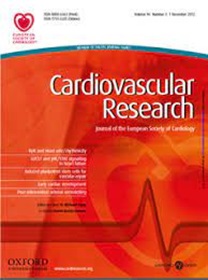Living myocardial slices: walking the path towards standardization
IF 13.3
1区 医学
Q1 CARDIAC & CARDIOVASCULAR SYSTEMS
引用次数: 0
Abstract
Cardiovascular disease remains a persistent global health burden, underscoring the necessity for effective therapeutic strategies. Despite significant advances, the ability to mechanistically study human disease and predict clinical outcomes remains limited, especially in complex diseases such as heart failure. This limitation is evident through the continuous high attrition rates in drug development pipelines. To address these challenges and contribute to improved pre-clinical studies, there is a need for platforms that more accurately recapitulate the human heart. This need increased the interest in living myocardial slices (LMS) – thin sections of the heart of approximately 100-400 μm. LMS retain the native multicellular architecture of the heart and enable extended ex vivo culture. However, as their utilization grows, so does variability in preparation methodologies and readouts. This review provides an overview of differences in sample selection, interspecies variations, intra-cardiac differences, and potential confounding factors. Additionally, we examine culture methods, addressing electrical and mechanical stimulation differences, and medium compositions. Our review concludes by highlighting the current limitations of LMS research and offer guidelines for standardization and future applications. The ultimate aim of this review is to serve as a resource for researchers working with LMS and for those entering this field. By presenting the landscape of methodological considerations, we aim to facilitate informed decision-making in study design and execution. We advocate for accurate reporting of methodologies to promote reproducibility and comparability across studies, advancing LMS research and strengthening its role as a valuable addition to the current drug development toolbox and basic cardiovascular research.活体心肌切片:走向标准化之路
心血管疾病仍然是一个持续存在的全球健康负担,强调了制定有效治疗战略的必要性。尽管取得了重大进展,但机械地研究人类疾病和预测临床结果的能力仍然有限,特别是在心力衰竭等复杂疾病中。这种限制通过药物开发管道中持续的高损耗率是显而易见的。为了应对这些挑战并促进临床前研究的改进,需要更准确地概括人类心脏的平台。这种需求增加了人们对活体心肌切片(LMS)的兴趣,活体心肌切片是大约100-400 μm的心脏薄片。LMS保留了心脏原有的多细胞结构,使体外培养成为可能。然而,随着它们的使用增长,制备方法和读数的变化也在增加。这篇综述概述了样本选择、种间变异、心脏内差异和潜在混杂因素的差异。此外,我们还研究了培养方法,解决电刺激和机械刺激的差异,以及培养基成分。我们的综述总结了LMS研究目前的局限性,并为标准化和未来应用提供了指导。本综述的最终目的是为LMS研究人员和进入该领域的人员提供资源。通过呈现方法学考虑的景观,我们的目标是促进研究设计和执行中的知情决策。我们提倡准确报告方法,以促进研究的可重复性和可比性,推进LMS研究,并加强其作为当前药物开发工具箱和基础心血管研究的宝贵补充的作用。
本文章由计算机程序翻译,如有差异,请以英文原文为准。
求助全文
约1分钟内获得全文
求助全文
来源期刊

Cardiovascular Research
医学-心血管系统
CiteScore
21.50
自引率
3.70%
发文量
547
审稿时长
1 months
期刊介绍:
Cardiovascular Research
Journal Overview:
International journal of the European Society of Cardiology
Focuses on basic and translational research in cardiology and cardiovascular biology
Aims to enhance insight into cardiovascular disease mechanisms and innovation prospects
Submission Criteria:
Welcomes papers covering molecular, sub-cellular, cellular, organ, and organism levels
Accepts clinical proof-of-concept and translational studies
Manuscripts expected to provide significant contribution to cardiovascular biology and diseases
 求助内容:
求助内容: 应助结果提醒方式:
应助结果提醒方式:


